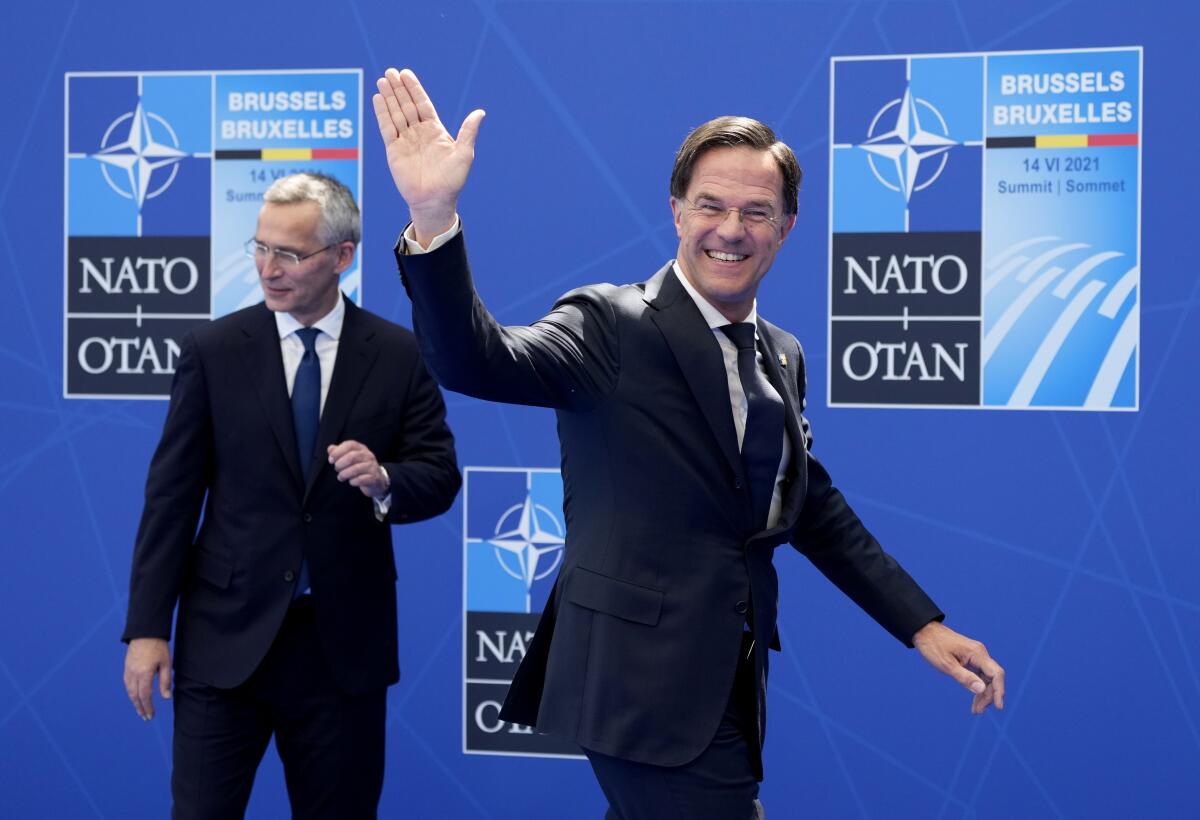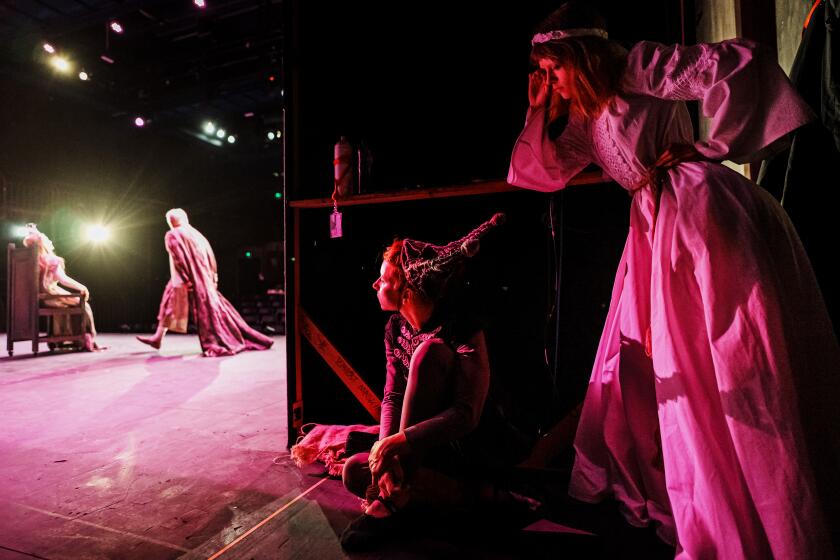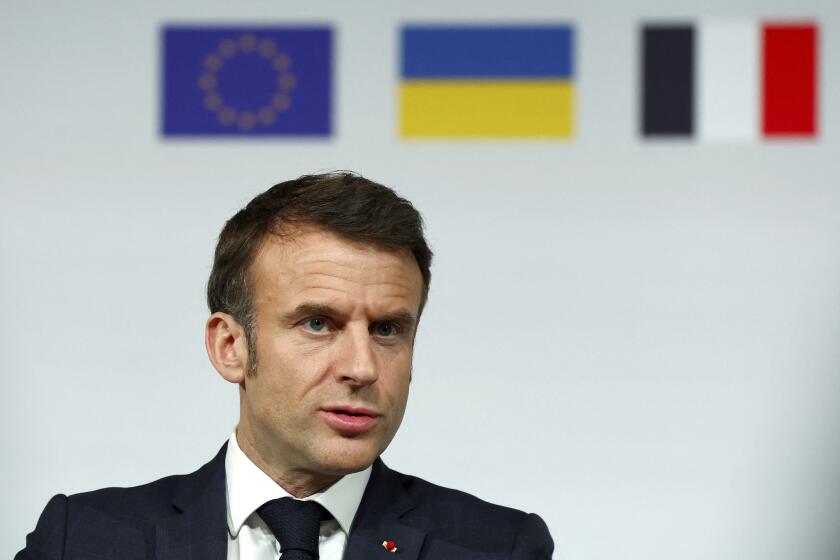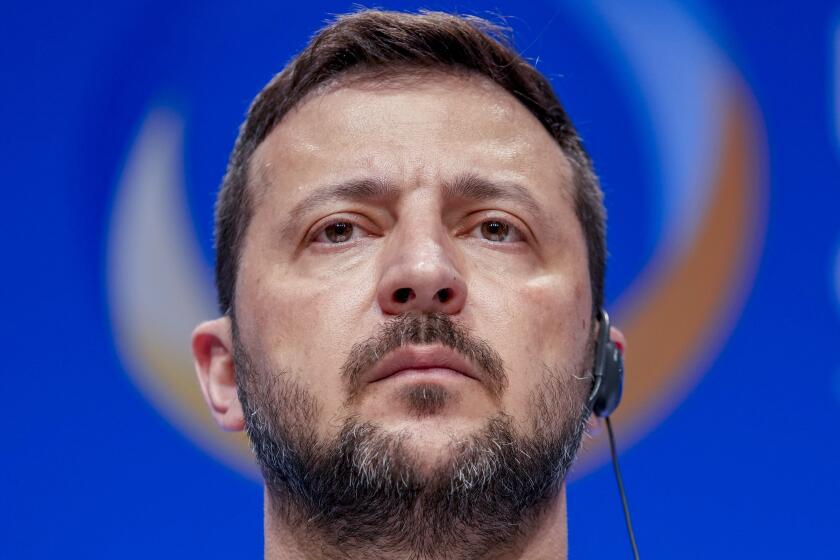‘Teflon Mark’ Rutte of the Netherlands set to be next NATO chief

- Share via
THE HAGUE, Netherlands — Over the course of more than a dozen years at the top of Dutch politics, Mark Rutte got to know a thing or two about finding consensus among fractious coalition partners. Now he’s on track to bring the experience of leading four Dutch multiparty governments to the international stage as NATO’s new secretary-general.
Romania’s president withdrew from the race for the alliance’s top job Thursday, leaving Rutte the only remaining candidate and all but certain to head the world’s biggest military organization from October.
Rutte’s appointment could be sealed by a meeting of NATO ambassadors in the coming days, or when President Biden and his NATO counterparts meet for a summit in Washington on July 9-11.
The secretary-general chairs meetings and guides sometimes delicate consultations among the 32 NATO member countries to ensure that an organization that operates on consensus can continue to function. The NATO leader also ensures that decisions are put into action and speak on behalf of all members.
Even before taking over from Jens Stoltenberg, Rutte has been put to the test.
Ukrainians displaced by war find new purpose in Shakespeare’s play of love, loss and madness, bringing their blood-red version to the bard’s hometown.
Securing the job of NATO chief required all of Rutte’s diplomatic skills as he convinced doubters, including Hungarian Prime Minister Viktor Orbán and Turkish President Recep Tayyip Erdogan, to back his candidacy.
“It took a very long time. It’s a complicated process, but it’s an honor that it appears to have happened,” Rutte told reporters in The Hague before riding his bicycle away from work.
A former NATO spokesperson said Rutte was a good fit for the job.
“Like Stoltenberg, Rutte is a pragmatist and one of the few European politicians to have developed a good working relationship not just with Joe Biden, but also with Donald Trump. That could prove a key asset for NATO after the November U.S. presidential election,” said Oana Lungescu, a former chief NATO spokesperson.
Rutte “is seen as a safe pair of hands to lead NATO in turbulent times, just as Stoltenberg has done for the last decade,” Lungescu, now a fellow with the defense and security think tank, the Royal United Services Institute, told the Associated Press.
From history scholar to business manager to politics
A history graduate and former human resources manager at consumer products multinational Unilever, Rutte became prime minister of the Netherlands for the first time in October 2010. He quit last July as his four-party coalition wrangled over how to rein in migration.
European Parliament elections yield victory for centrists, but in France, far-right landslide triggers snap parliamentary elections.
Rutte can often be seen riding his bicycle around his hometown of The Hague, or walking from his office to a meeting eating an apple. When he handed in his government’s resignation to King Willem-Alexander last year, he drove to an ornate royal palace in a Saab station wagon.
On Thursday, he posed — in jeans, a white shirt and sunglasses — for selfies with people outside his office while sitting on his bicycle.
While he was Dutch prime minister, Rutte was a strong supporter of Ukraine and its right to defend itself after Russia’s 2022 invasion. Under his leadership, the Netherlands pledged military hardware to Kyiv including Leopard tanks and F-16 fighter jets.
He said the war on Europe’s eastern flank was one of the reasons for seeking the job as NATO chief.
“With everything that happened in Ukraine and the instability in the world and a number of people who thought I could maybe do it, you can’t just push that to one side,” he said. “And it is, of course, an unbelievably interesting job.”
Rutte’s political career survived scandals
Rutte bounced back from a number of scandals while in office in the Netherlands. He was so adept at preventing political stains sticking to him that he earned the nickname Teflon Mark.
His third coalition government resigned in early 2021 over a scandal involving investigations into child welfare payments that wrongly labeled thousands of parents as fraudsters.
A few months later, Rutte proved himself a master of survival by leading his conservative People’s Party for Freedom and Democracy to victory in national elections and cobbling together his fourth and final coalition from the same parties that resigned to trigger the vote.
Ukrainian President Zelensky is all over Europe, including at the G-7. His message? Ukraine’s war with Russia and Putin is Europe’s fight, too.
Experience on the international political stage
Working the room at European Union summits, Rutte developed relationships with powerful leaders such as former German chancellor Angela Merkel and France’s Emmanuel Macron. He’s also visited Biden and Trump in Washington.
“As a veteran of EU summits, Rutte will bring a different understanding of the complex NATO-EU relation than Stoltenberg,” said Lungescu. “But he will also need to ensure that the EU’s efforts on defense complement, rather than undermine NATO at this critical time.”
While the Netherlands under Rutte’s leadership long failed to meet the NATO target of spending 2% of its GDP on defense, the Dutch are expected to edge past the mark this year.
NATO estimates suggest the Netherlands will spend 2.05% of its GDP, up from around 1.2% a decade ago when the allies pledged to ramp up their military budgets after Russia annexed Crimea.
Corder writes for the Associated Press. AP writer Lorne Cook in Brussels contributed to this report.
More to Read
Sign up for Essential California
The most important California stories and recommendations in your inbox every morning.
You may occasionally receive promotional content from the Los Angeles Times.













